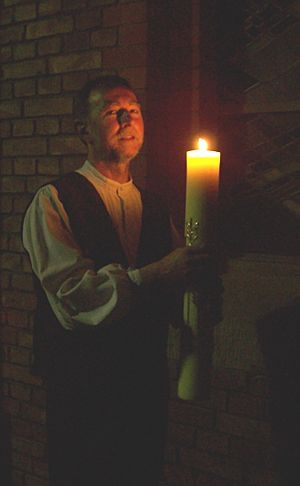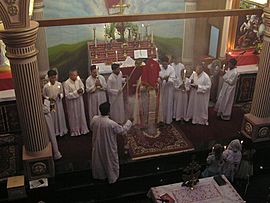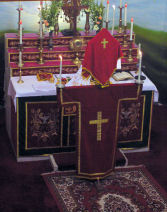Easter Vigil facts for kids
Quick facts for kids Easter Vigil |
|
|---|---|
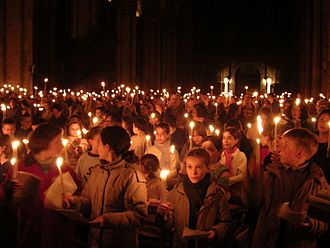
The congregation with candles as part of the vigil at Chartres Cathedral
|
|
| Official name | Easter Vigil |
| Observed by | Christians |
| Type | Religious |
| Date | Lua error in Module:Wikidata at line 132: attempt to index field 'wikibase' (a nil value). |
| 2024 date |
|
| Frequency | annual |
| First time | unknown |
| Related to | Sunrise service |
The Easter Vigil is a very special church service held by Christians. It's also called the Paschal Vigil or the Great Vigil of Easter. This service is the first official celebration of Jesus' Resurrection (when he came back to life).
Historically, during this service, new members are welcomed into the Church. Adults who have been learning about Christianity are often baptized at this time. The vigil happens in the dark hours between sunset on Holy Saturday and sunrise on Easter Day. It's usually held on Saturday evening or at midnight. This service is the very first celebration of Easter.
For many Christian churches in the West, like the Roman Catholic Church, Lutheran Churches, and Anglican Communion, the Easter Vigil is the most important service of the year. It's the first time since Lent (a period of fasting) that the joyful word "Alleluia" is used. This word is a key part of the Easter season.
In Eastern Orthodox and Oriental Orthodox churches, the Easter Vigil ceremonies are very festive. They are unique to this night and are the most important services of their church year. Some other traditions, like Moravians, Reformed, and Methodist churches, also observe the Easter Vigil or hold a sunrise service.
Contents
What is the Easter Vigil?
The Easter Vigil is a Christian service that celebrates the night Jesus rose from the dead. It is a time of great joy and hope for Christians around the world. This service marks the end of Lent and the beginning of the Easter season.
How is the Easter Vigil Celebrated?
The Easter Vigil is usually divided into four main parts. These parts tell the story of God's plan for salvation, from creation to Jesus' resurrection. They also welcome new members into the church.
The Service of Light
The vigil begins outside the church, often after sunset on Holy Saturday. A special Easter fire is lit in the darkness. From this fire, a large candle called the Paschal candle is lit. This candle represents Jesus Christ as the "Light of the World."
The Paschal candle is then carried into the dark church. It stops three times, and each time the leader chants "Light of Christ." The people respond, "Thanks be to God." As the candle moves, people light their small candles from the Paschal candle. This shows how the light of Christ spreads and overcomes darkness.
After the candle is in place, a special song called the Exsultet (or "Easter Proclamation") is sung. This song praises God and celebrates the resurrection.
The Liturgy of the Word
After the Service of Light, the church lights are turned on. Everyone sits for the Liturgy of the Word. This part includes several readings from the Old Testament of the Bible. These readings tell important stories from history, like the creation of the world and the Israelites crossing the Red Sea.
Each reading is followed by a psalm or song and a prayer. These prayers connect the Old Testament stories to Jesus' life and resurrection. After these readings, the church bells ring, and the organ plays for the first time since Lent began. The "Gloria in Excelsis Deo" (a hymn of praise) is sung.
Then, a reading from the New Testament is shared, followed by the joyful "Alleluia." Finally, a Gospel reading about Jesus' resurrection is proclaimed, and the priest gives a homily (a sermon).
The Rite of Baptism
This part of the vigil is very special. The water in the baptismal font is blessed. If there are people becoming new members of the church, they are baptized or confirmed at this time. After this, everyone in the congregation renews their own baptismal vows. They promise to follow Jesus and live as Christians. Sometimes, holy water is sprinkled on everyone as a reminder of their baptism.
The Liturgy of the Eucharist
The final part of the Easter Vigil is the Liturgy of the Eucharist, also known as Mass or Holy Communion. This is the first Mass of Easter Day. During this part, the newly baptized people receive Holy Communion for the very first time. The service usually finishes before dawn on Easter Sunday.
Easter Vigil in Different Churches
Catholic Church

In the Roman Catholic Church, the Easter Vigil is considered the most important and noble celebration of the year. It follows the four parts described above: the Service of Light, the Liturgy of the Word, the Rite of Baptism, and the Liturgy of the Eucharist. The readings from the Old Testament are very important, especially the story of the Israelites crossing the Red Sea. This story is seen as a sign of Jesus' victory over death.
In the 1950s, Pope Pius XII made some changes to the Easter Vigil. Before this, the service was held on Saturday morning. He moved it to after sunset, which is closer to the traditional time of Jesus' resurrection. He also simplified some parts of the service.
Lutheran Churches
The Easter Vigil is also a popular service in Lutheran churches. It is often celebrated early on Easter Sunday morning. Lutherans use their own language in the service, along with traditional Latin texts like the Exsultet. They focus on Bible readings, singing, and the Easter sermon.
After World War I, there was a movement in German Lutheran churches to bring back the Easter Vigil. This helped inspire changes in the Roman Catholic Easter Vigil too. Today, many Lutheran churches in North America also observe the Easter Vigil, sometimes including the blessing of the new fire.
Anglican Churches
While not all Anglican churches celebrate the Easter Vigil, it has become much more common recently. The service in Anglican churches is very similar to the Roman Catholic one. It also has the four main parts: the Service of Light, the Service of Lessons (readings), Christian Initiation (baptism or renewal of vows), and the Holy Eucharist.
One difference is that in some Anglican services, the "Gloria" hymn is sung after the baptism or renewal of vows. Also, the number and specific Bible readings can vary.
Reformed Churches
In Reformed churches, the Easter Vigil also follows the pattern of Service of Light, Service of the Word, Service of Baptism, and Service of Communion. It can start on Saturday night or be held as a sunrise service on Easter Sunday.
Methodist Churches
Methodist congregations that observe the Easter Vigil also divide it into four parts. The Service of Light begins outside in the dark, with a new fire and the lighting of the Paschal Candle. A procession then enters the church. The Service of the Word includes readings about creation, God's promises, and new life.
The Service of the Baptismal Covenant involves baptisms and confirmations for new members. Finally, the Service of the Table celebrates Holy Communion. The service ends with a blessing and a hymn.
Eastern Christian Churches
Byzantine Rite
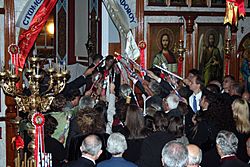
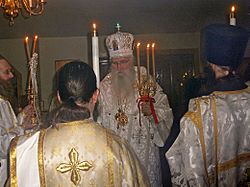
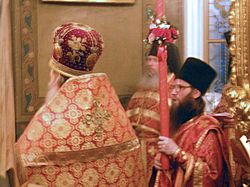
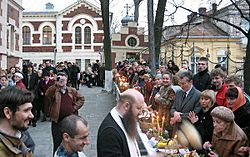
In Eastern Orthodox churches, the Paschal Vigil is a very long and joyful service. It starts with a special service called Great Vespers on Saturday afternoon. During this service, new members may be baptized. The church decorations are dramatically changed from dark colors to white, showing the joy of the resurrection.
The main part of the vigil begins around midnight on Saturday. All the lights in the church are turned off. The priest lights his candle from a special "unsleeping flame" on the altar. Then, he shares this light with the congregation, who light their own candles.
A procession goes three times around the outside of the church, singing a hymn about the resurrection. This reminds people of the women who went to Jesus' empty tomb. When they return to the church, the joyful "Christ is risen!" greeting is exchanged for the first time.
The rest of the service is filled with joyful singing. Nothing is read; everything is sung. Priests walk through the church, continually exchanging the "Christ is risen!" greeting. Towards the end, a special sermon by St. John Chrysostom is read. Red-dyed eggs are blessed and shared, marking the end of the long Lent fast. The service often finishes very early on Sunday morning.
The week after Easter Sunday is called Bright Week. During this week, the church doors are left open, and many of the special Easter services continue. It's a time of continuous celebration.
Indian Orthodox Church
In the Indian Orthodox Church, the vigil begins on Good Friday evening. People spend time in church reading scriptures and singing hymns. The main service, similar to the Easter Vigil, happens very early on Sunday morning, around 3 a.m. However, in many places, it's now held on Saturday evening for practical reasons.
A dramatic moment is the "Announcement." All lights are turned off except for the altar candles. The chief priest stands in the sanctuary, holding a cross covered in red cloth. He announces three times, "Dearly beloved, I bring you all news of great joy. Our Lord Jesus Christ has resurrected from the dead and defeated His enemies." The congregation joyfully responds, "Truly, we believe that He rises!”
A procession then goes around the church, with everyone holding lighted candles. A special hymn is sung. After this, the "Kiss of Peace" is shared, and the Holy Qurbana (Communion service) takes place. At the end, the Easter Cross is used to bless the congregation.
From Easter until the Feast of the Cross, the Easter Cross is placed on a special stand called Golgotha in the sanctuary. This reminds everyone of Jesus' victory.
Images for kids
See also
 In Spanish: Vigilia pascual para niños
In Spanish: Vigilia pascual para niños


